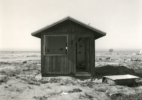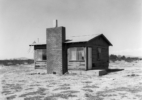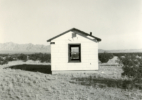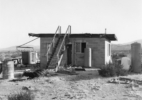Recent Work
May 13 - July 8, 2006
Gallery Luisotti is pleased to announce its upcoming exhibition, featuring recent photographs by Mark Ruwedel. Consisting of a suite of recent works never previously exhibited, Mark Ruwedel’s new exhibition documents shelters throughout the desert of Southern California. Recording abandoned, temporary dwellings, provisional and mobile housing, as well as the makeshift refuges of illegal border crossers, Ruwedel’s photographs capture the incongruous nature of desert dwellings.
Mark Ruwedel’s photographs have always documented the markings of humanity in the western landscape. Ruwedel has photographed disused 19th century railway paths, atomic testing sites, and ancient ceremonial areas. Ruwedel’s work is like an archeological dig, dividing and exposing the layers of history strewn throughout the vast western United States. The photographs themselves are typically presented on mounts, each inscribed with the place name of that which is depicted. This method references 19th century American topographic photography, adding an additional critical layer to the history Ruwedel’s photographs expose.
In this stunning new body of work, Ruwedel’s camera focuses on the immediate, contemporary history of the desert Southwest. These photographs capture ramshackle structures throughout the California desert. In an area with loose building codes, small shelters can be built under the most crude means. In similar territory, more aspiring homes crop up as well. Ruwedel finds many provisional structures across these exurban lands. Some are ad-hoc abodes on wheels (but not quite mobile homes), while others are informal structures built of immediately available scrap materials, from mattresses to sheet metal. Yet the most stark portrait of shelter is found in those images of campsites created by those illegally crossing the Mexican-US border. These unassuming plots, between rocks or beneath a shaded grove, hold deflated tires, bottles of water, and occasionally an abandoned passport.







